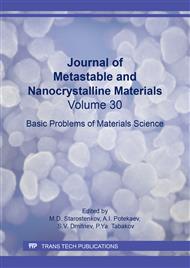[1]
O. Chen, J. Zhao, V. P. Chauhan, J. Cui, C. Wong, D. K. Harris, H. Wei, H-S. Han, D. Fukumura, R. K. Jain and M. G. Bawendi, Compact high-quality CdSe-CdS core-shell nanocrystals with narrow emission linewidths and suppressed blinking, Nature materials 12 (2013).
DOI: 10.1038/nmat3539
Google Scholar
[2]
O. Chen, L. Riedemann, et al., Magneto-fluorescent core-shell supernanoparticles, Nature communications 5 (2014) 5093.
Google Scholar
[3]
H. Wu, N. Du, H. Zhang, D. Yang, Voltage-controlled synthesis of Cu–Li2O@Si core–shell nanorod arrays as high-performance anodes for lithium-ion batteries, Journal of Materials Chemistry A 2 (2014) 20510-20514.
DOI: 10.1039/c4ta05098c
Google Scholar
[4]
W. Zhao, N. Du, H. Zhang, D. Yang, Silver–nickel oxide core-shell nanoflower arrays as high-performance anode for lithium-ion batteries, Journal of Power Sources 285 (2015) 131-136.
DOI: 10.1016/j.jpowsour.2015.03.088
Google Scholar
[5]
T. Liu, D. Li, Y. Zou, D. Yang, Li H., Y. Wu, M. Jiang, Preparation of metal@ silica core–shell particle films by interfacial self-assembly, Journal of colloid and interface science 350 (2010) 58-62.
DOI: 10.1016/j.jcis.2010.05.092
Google Scholar
[6]
R.G. Chaudhuri, S. Paria, Core/shell nanoparticles: classes, properties, synthesis mechanisms, characterization, and application, Chemical reviews 112 (2011) 2373-2433.
DOI: 10.1021/cr100449n
Google Scholar
[7]
S. Zhuo, M. Shao, L. Cheng, R. Que, D. Ma, S. T. Lee, Surface-enhanced fluorescence from copper nanoparticles on silicon nanowires, Frontiers of Optoelectronics in China 4 (2011) 114-120.
DOI: 10.1007/s12200-011-0152-y
Google Scholar
[8]
Q. Yao, Z. -H. Lu, Z. Zhang, X. Chen, Y. Lan, One-pot synthesis of core-shell Cu@SiO2 nanospheres and their catalysis for hydrolytic dehydrogenation of ammonia borane and hydrazine borane, Scientific Reports 4 (2014) 7497.
DOI: 10.1038/srep07597
Google Scholar
[9]
T. Liu, D. Li, Y. Zou, D. Yang, H. Li, Y. Wu, M.J. Jiang, Preparation of metal@silica core–shell particle films by interfacial self-assembly, Colloid Interface Sci. 350 (2010) 58-62.
DOI: 10.1016/j.jcis.2010.05.092
Google Scholar
[10]
J. Ye., B. De Broek, R. D. Palma, W. Libaers, K. Clays, W. V. Roy, G. Borghs, G. Maes, Surface morphology changes on silica-coated gold colloids, Colloids Surf. A. 322 (2008) 225-233.
DOI: 10.1016/j.colsurfa.2008.03.033
Google Scholar
[11]
W.F. Paxton, K.C. Kistler, Ch.C. Olmeda, A. Sen, S.K. St. Angelo, Y. Cao, Th.E. Mallouk, P.E. Lammert and V. H. Crespi, Catalytic Nanomotors: Autonomous Movement of Striped Nanorods, Journal of the American Chemical Society 126 (2004).
DOI: 10.1002/chin.200452205
Google Scholar
[12]
S. Fournier-Bidoz, A.C. Arsenault, I. Manners and G.A. Ozin, Chemical Communications 4 (2005) 441-443.
DOI: 10.1039/b414896g
Google Scholar
[13]
H. Yu, M. Chen, Ph. M. Rice, Sh. X. Wang, R. L. White and Sh. Sun, Dumbbell-like Bifunctional Au−Fe3O4 Nanoparticles, Nano letters 5 (2005) 379-382.
DOI: 10.1021/nl047955q
Google Scholar
[14]
R. Ferrando, J. Jellinek, R. L. Johnston, Nanoalloys: From Theory to Applications of Alloy Clusters and Nanoparticles, Chemical Reviews 108 (2008) P. 845-910.
DOI: 10.1021/cr040090g
Google Scholar
[15]
Y. Song, K. Liu, S. Chen, AgAu Bimetallic Janus Nanoparticles and Their Electrocatalytic Activity for Oxygen Reduction in Alkaline Media, Langmuir 28 (2012) 17143-17152.
DOI: 10.1021/la303513x
Google Scholar
[16]
A. V. Nomoev, S. P. Bardakhanov, M. Schreiber, D. G. Bazarova, N. A. Romanov, B. B. Baldanov, B. R. Radnaev, V. V. Syzrantsev, Structure and mechanism of the formation of core–shell nanoparticles obtained through a one-step gas-phase synthesis by electron beam evaporation, Beilstein journal of nanotechnology 6 (2015).
DOI: 10.1515/nano.bjneah.6.89
Google Scholar
[17]
Y. Chushak, L.S. Bartell, Molecular dynamics simulations of the freezing of gold nanoparticles, J. Eur. Phys. D. 16 (2001) 43-46.
DOI: 10.1007/s100530170056
Google Scholar
[18]
S. Iijima and T. Ichihashi, Structural instability of ultrafine particles of metals, J. Phys. Rev. Lett. 56 (1986) 616.
DOI: 10.1103/physrevlett.56.616
Google Scholar
[19]
S. Sugano, H. Koizumi, Microcluster Physics. Springer Series in Materials Science, Springer Verlag, Berlin, (1998).
Google Scholar
[20]
P. Moriarty, Nanostructured materials, J. Rep. Prog. Phys. 64 (2001) 297-381.
Google Scholar
[21]
R. Kofman, P. Cheyssac, Y. Lereah and A. Stella, Melting of cluster approaching 0D, J. Eur. Phys. D. 3 (1999) 441-444.
DOI: 10.1007/978-3-642-88188-6_88
Google Scholar
[22]
A. Pundt, M. Dornheim, M. Guerdane H. Teichler, H. Ehrenberg, M.T. Reetz, N.M. Jisrawi, Evidence for a cubic-to-icosahedral transition of quasi free Pd-H clusters controlled by the hydrogen content, J. Eur. Phys. D. 19 (2002) 333-337.
DOI: 10.1140/epjd/e20020080
Google Scholar
[23]
L.D. Marks, Experimental studies of small particle structures, J. Rep. Prog. Phys. 57 (1994) 603-649.
DOI: 10.1088/0034-4885/57/6/002
Google Scholar
[24]
J.A. Ascencio, M. Perez and M. Jose-Yacaman, A truncated icosahedral structure observed in gold nanoparticles, J. Surf. Sci. 447 (2000) 73-80.
DOI: 10.1016/s0039-6028(99)01112-7
Google Scholar
[25]
T.P. Martin, Shells of atoms, J. Phys. Reports 273 (1996) 199-241.
Google Scholar
[26]
J.M. Soler, M.R. Beltran, K. Michaelian, I.L. Garzon, P. Ordejon, D. Sanchez-Portal, E. Artacho, Metallic bonding and cluster structure, J. Phys. Rev. B61 (2000) 5771.
DOI: 10.1103/physrevb.61.5771
Google Scholar
[27]
C.L. Cleveland, W.D. Luedike, U. Landman, Melting of gold clusters: icosahedral precursours, Phys. Rev. Lett. 81 (1998) (2036).
DOI: 10.1103/physrevlett.81.2036
Google Scholar
[28]
K. Mannien and M. Mannien, Stacking faults in close-packed clusters, J. Eur. Phys. D 20 (2002) 243-249.
Google Scholar
[29]
V. V. Srdić, B. Mojić, M. Nikolić, S. Ognjanović, Recent progress on synthesis of ceramic core/shell nanostructures, Processing and Application of Ceramics 7 (2013) 45-62.
Google Scholar
[30]
M.J. Kim, Y.H. Chao, D.H. Kim, K.H. Kim, Magnetic Behaviors of Surface Modified Superparamagnetic Magnetite Nanoparticles, Magn. IEEE Trans. 45 (2009) 2446-2449.
DOI: 10.1109/tmag.2009.2018606
Google Scholar
[31]
B. Jelinek, S. Groh, M. F. Horstemeyer, J. Houze, S. G. Kim, G. J. Wagner, A. Moitra, M. I. Baskes, Modified embedded atom method potential for Al, Si, Mg, Cu, and Fe alloys, Physical Review B. 85 (2012) 245102.
DOI: 10.1103/physrevb.85.245102
Google Scholar
[32]
C. A. Cruz, P. Chantrenne, R. G. A. Veiga, M. Perez, X. Kleber, Modified embedded-atom method interatomic potential and interfacial thermal conductance of Si-Cu systems: A molecular dynamics study, Journal of Applied Physics 113 (2013) 023710.
DOI: 10.1063/1.4773455
Google Scholar


